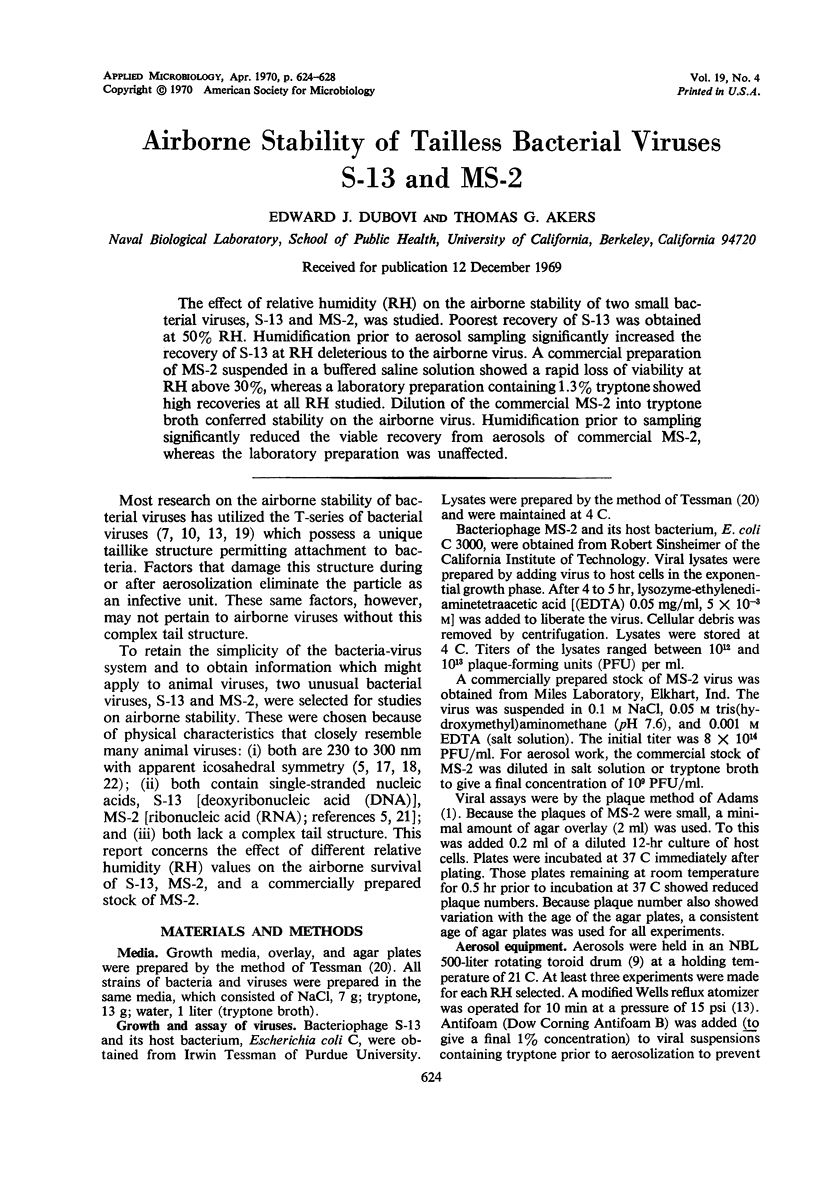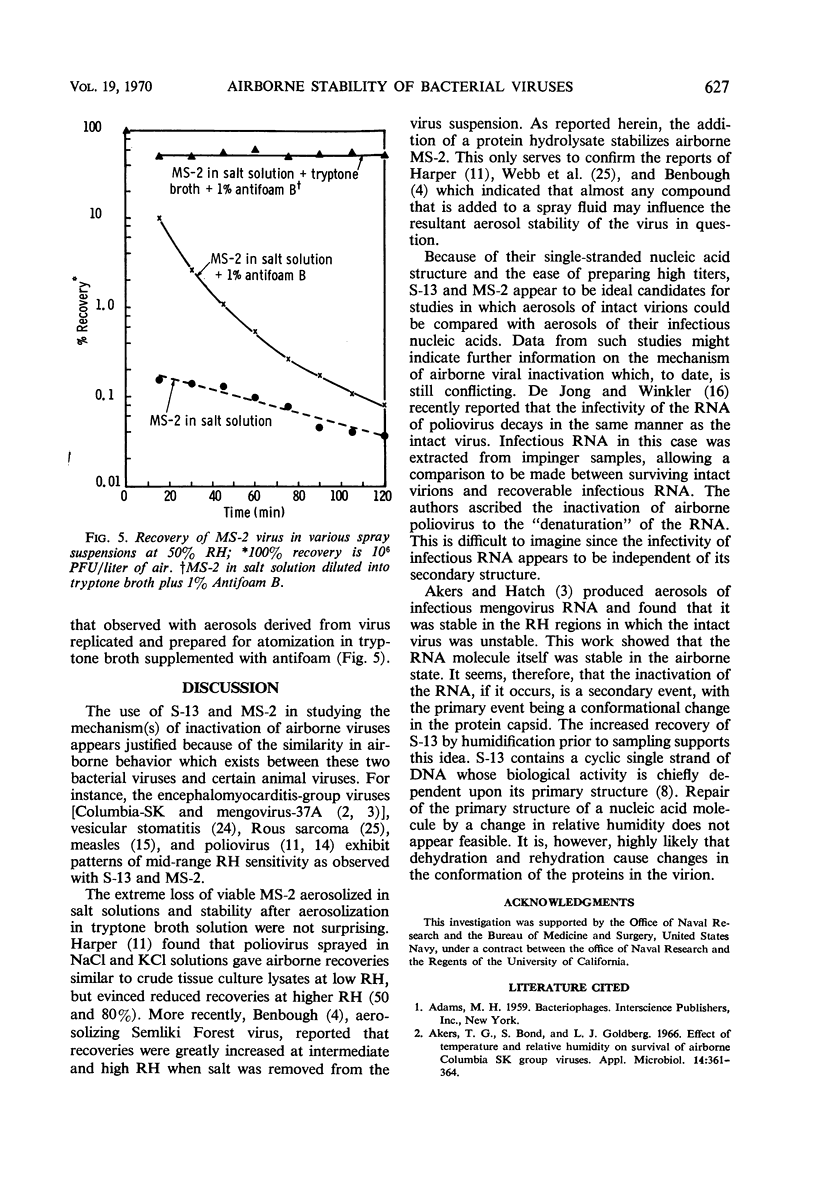Abstract
The effect of relative humidity (RH) on the airborne stability of two small bacterial viruses, S-13 and MS-2, was studied. Poorest recovery of S-13 was obtained at 50% RH. Humidification prior to aerosol sampling significantly increased the recovery of S-13 at RH deleterious to the airborne virus. A commercial preparation of MS-2 suspended in a buffered saline solution showed a rapid loss of viability at RH above 30%, whereas a laboratory preparation containing 1.3% tryptone showed high recoveries at all RH studied. Dilution of the commercial MS-2 into tryptone broth conferred stability on the airborne virus. Humidification prior to sampling significantly reduced the viable recovery from aerosols of commercial MS-2, whereas the laboratory preparation was unaffected.
Full text
PDF




Selected References
These references are in PubMed. This may not be the complete list of references from this article.
- Akers T. G., Bond S., Goldberg L. J. Effect of temperature and relative humidity on survival of airborne Columbia SK group viruses. Appl Microbiol. 1966 May;14(3):361–364. doi: 10.1128/am.14.3.361-364.1966. [DOI] [PMC free article] [PubMed] [Google Scholar]
- Akers T. G., Hatch M. T. Survival of a picornavirus and its infectious ribonucleic acid after aerosolization. Appl Microbiol. 1968 Nov;16(11):1811–1813. doi: 10.1128/am.16.11.1811-1813.1968. [DOI] [PMC free article] [PubMed] [Google Scholar]
- Benbough J. E. The effect of relative humidity on the survival of airborne Semliki forest virus. J Gen Virol. 1969 Jun;4(4):473–477. doi: 10.1099/0022-1317-4-4-473. [DOI] [PubMed] [Google Scholar]
- DE JONG J. G. THE SURVIVAL OF MEASLES VIRUS IN AIR, IN RELATION TO THE EPIDEMIOLOGY OF MEASLES. Arch Gesamte Virusforsch. 1965;16:97–102. doi: 10.1007/BF01253797. [DOI] [PubMed] [Google Scholar]
- DIMMICK R. L., HATCH M. T., NG J. A particle-sizing method for aerosols and fine powders. AMA Arch Ind Health. 1958 Jul;18(1):23–29. [PubMed] [Google Scholar]
- EHRLICH R., MILLER S., IDOINE L. S. EFFECTS OF ENVIRONMENTAL FACTORS ON THE SURVIVAL OF AIRBORNE T-3 COLIPHAGE. Appl Microbiol. 1964 Nov;12:479–482. doi: 10.1128/am.12.6.479-482.1964. [DOI] [PMC free article] [PubMed] [Google Scholar]
- FIERS W., SINSHEIMER R. L. The structure of the DNA of bacteriophage phi-X174. III. Ultracentrifugal evidence for a ring structure. J Mol Biol. 1962 Oct;5:424–434. doi: 10.1016/s0022-2836(62)80031-x. [DOI] [PubMed] [Google Scholar]
- GOLDBERG L. J., WATKINS H. M., BOERKE E. E., CHATIGNY M. A. The use of a rotating drum for the study of aerosols over extended periods of time. Am J Hyg. 1958 Jul;68(1):85–93. doi: 10.1093/oxfordjournals.aje.a119954. [DOI] [PubMed] [Google Scholar]
- HEMMES J. H., WINKLER K. C., KOOL S. M. Virus survival as a seasonal factor in influenza and poliomylitis. Antonie Van Leeuwenhoek. 1962;28:221–233. doi: 10.1007/BF02538737. [DOI] [PubMed] [Google Scholar]
- Happ J. W., Harstad J. B., Buchanan L. M. Effect of air ions on submicron t1 bacteriophage aerosols. Appl Microbiol. 1966 Nov;14(6):888–891. doi: 10.1128/am.14.6.888-891.1966. [DOI] [PMC free article] [PubMed] [Google Scholar]
- Hatch M. T., Dimmick R. L. Physiological responses of airborne bacteria to shifts in relative humidity. Bacteriol Rev. 1966 Sep;30(3):597–603. doi: 10.1128/br.30.3.597-603.1966. [DOI] [PMC free article] [PubMed] [Google Scholar]
- Hatch M. T., Warren J. C. Enhanced recovery of airborne T3 coliphage and Pasteurella pestis bacteriophage by means of a presampling humidification technique. Appl Microbiol. 1969 May;17(5):685–689. doi: 10.1128/am.17.5.685-689.1969. [DOI] [PMC free article] [PubMed] [Google Scholar]
- MACLEAN E. C., HALL C. E. Studies on bacteriophage phi-X174 and its DNA by electron microscopy. J Mol Biol. 1962 Mar;4:173–178. doi: 10.1016/s0022-2836(62)80049-7. [DOI] [PubMed] [Google Scholar]
- SCOTT D. W. SEROLOGICAL CROSS REACTIONS AMONG THE RNA-CONTAINING COLIPHAGES. Virology. 1965 May;26:85–88. doi: 10.1016/0042-6822(65)90028-0. [DOI] [PubMed] [Google Scholar]
- Songer J. R. Influence of relative humidity on the survival of some airborne viruses. Appl Microbiol. 1967 Jan;15(1):35–42. doi: 10.1128/am.15.1.35-42.1967. [DOI] [PMC free article] [PubMed] [Google Scholar]
- TESSMAN E. S. COMPLEMENTATION GROUPS IN PHAGE S13. Virology. 1965 Feb;25:303–321. doi: 10.1016/0042-6822(65)90208-4. [DOI] [PubMed] [Google Scholar]
- TESSMAN I. Some unusual properties of the nucleic acid in bacteriophages S13 and phi X174. Virology. 1959 Mar;7(3):263–275. doi: 10.1016/0042-6822(59)90197-7. [DOI] [PubMed] [Google Scholar]
- Vasquez C., Granboulan N., Franklin R. M. Structure of the ribonucleic acid bacteriophage R17. J Bacteriol. 1966 Dec;92(6):1779–1786. doi: 10.1128/jb.92.6.1779-1786.1966. [DOI] [PMC free article] [PubMed] [Google Scholar]
- Warren J. C., Akers T. G., Dubovi E. J. Effect of prehumidification on sampling of selected airborne viruses. Appl Microbiol. 1969 Nov;18(5):893–896. doi: 10.1128/am.18.5.893-896.1969. [DOI] [PMC free article] [PubMed] [Google Scholar]
- de Jong J. C., Winkler K. C. The inactivation of poliovirus in aerosols. J Hyg (Lond) 1968 Dec;66(4):557–565. doi: 10.1017/s0022172400028308. [DOI] [PMC free article] [PubMed] [Google Scholar]


